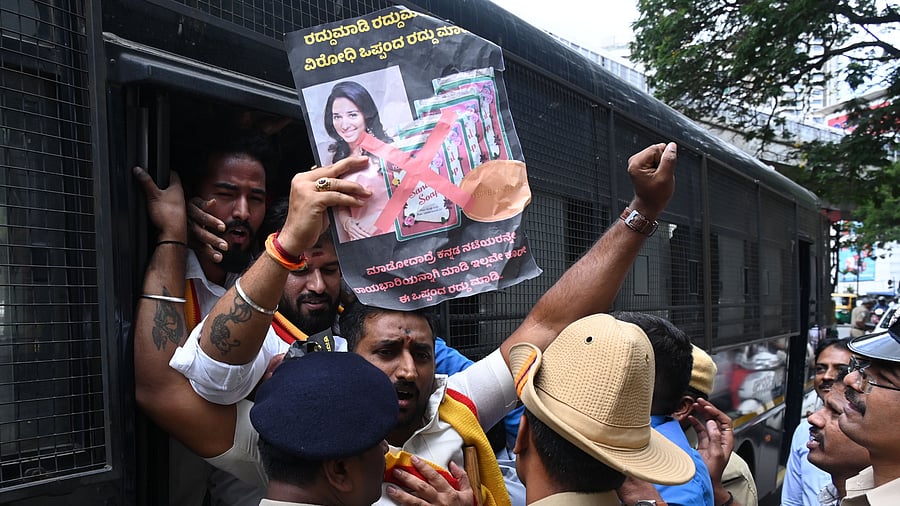
Kannada activists last week staged a protest at KSDL, Yeshwantpur, demanding the removal of its new ambassador Tamannaah Bhatia.
Credit: DH Photo/B K Janardhan
While netizens took to social media to express their displeasure over Karnataka Soaps and Detergents Ltd (KSDL)’s new brand ambassador, Bengaluru-based marketing and advertising experts say it depends on several factors. The celebrity’s popularity with the target audience, their availability, prior associations with rival brands, and their fees are some of the points that are taken into consideration.
The backlash concerns the appointment of Mumbai-born actor Tamannaah Bhatia as the new face of Mysore Sandal Soap and other products by KSDL. Tamannaah, known for her work in Telugu, Tamil, and Hindi cinema, has reportedly signed the deal for Rs 6.20 crore. In Sandalwood, she has appeared in an item song in ‘KGF’.
Critics, including Mysuru royal scion Yaduveer Wadiyar and actor-politician Ramya (Divya Spandana), condemned the decision, arguing that it sidelines regional ties and even reinforces outdated beauty standards. Activists pointed out that Kannada stars such as the late Puneeth Rajkumar, and Daali Dhananjaya have endorsed state-run brands without charging a fee. In response, Karnataka’s industries minister M B Patil defended the decision on X, stating that the brand intends to expand aggressively beyond Karnataka.
Brand strategy specialist Harish Bijoor called the backlash a “non-debate”. “Brands are not about charity — they are about commerce,” he said. He added that the choice of ambassador is sharply tied to the brand’s expansion plans, which can be local, national, or global at different points in their journey.
Communications consultant Karthik Srinivasan echoed the view, noting that several legacy brands from Gujarat have expanded nationally by partnering with Bollywood celebrities who have a broader appeal. While he acknowledged that actresses like Deepika Padukone, Rashmika Mandanna, or Pooja Hegde — all from Karnataka with a pan-India presence — could have been fitting choices, he cautioned against rushing to judgement. “What if Tamannaah plays an outsider in the campaign — someone visiting Karnataka and discovering our rich legacy of sandalwood?” he said. Such a narrative, according to him, could still honour the brand’s cultural roots while attracting a new audience.
Today, multilingual films and OTT platforms have given regional stars pan-India visibility. However, Sujay Ghosh, executive vice president at an ad agency, argued that recognition is relative. “In this age of short attention span, a known face may not register with a new target audience as instantly as a superstar’s face would,” he said. “If a brand wants to grow rapidly at the national level, a widely recognised face helps accelerate that. A local figure may take longer to capture a new market,” he continued. According to him, there are various ways of fixing moral responsibility on a regional brand beyond simply choosing a local ambassador. He offered a scenario: “If the brand grows fast, it can bring more jobs back home and deliver greater dividends to the state.”
Read the context
Academic and writer Chandan Gowda pointed out that the use of non-Kannada ambassadors by KSDL is not without precedent — cricketer M S Dhoni was chosen as its first endorser in 2006, despite Karnataka’s rich sporting talent. But he emphasised that the context has shifted, with heightened linguistic tensions and political competition over cultural representation. In this climate, KSDL has been caught on the wrong foot, he remarked. However, Sudha Sitharaman, a sociology professor from Bengaluru now teaching in Puducherry, argued that the expansion of heritage brands must follow a culturally attuned approach. She advocated for choosing local ambassadors, saying it offers a chance to amplify both the product and the personality in new markets. “And even then, care must be taken that the ambassador’s fame doesn’t overshadow the product’s appeal.”